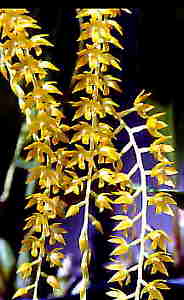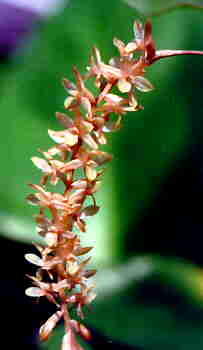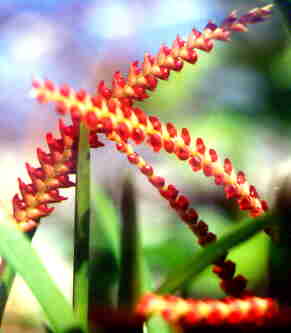BP SPECIES NEWSLETTER MARCH 2001
- Up to Date Flask and Plant lists,
emailed on request
- www.speciesorchids.com our new domain and web site.
- A. What's New in Flask, Dendrobium
punaceum, Phalaenopsis formosanus, Laelia jongheana.
- B. What's Ready to
replate, Cattleya deckerii alba x self, Cattleyopsis ortgesiana,
Spathoglottis species Sulawasi White, Dendrobium Sepik Blue,
lasianthera.
- C. What's New in Plants, Dend Sepik Blue, Dossinia
marmorata, jewel, Dend palpaebrae, Dendrochilum, Paph laevigatum.
EXPORT OF PAPHIOPEDILUM PLANTS & CITES.
- D. Culture. Dendrochilum.
- E. Web Site www.speciesorchids.com.
- F. Humour.
- G. Unsubscribe from this newsletter
 Photos in this
issue: Dendrochilum formosanum (left), Dendrochilum
convollarieforme, Dendrochilum saccolabium. Photos in this
issue: Dendrochilum formosanum (left), Dendrochilum
convollarieforme, Dendrochilum saccolabium.
Do you know any orchid growers who may like to receive this newsletter? Why
not forward this email to them now! Email bporchid@ultra.net.au
for emailed plant and flask lists or visit our web site at www.speciesorchids.com
and fill in the online form.
Items in this newsletter may be reproduced provided source
acknowledged.
We commend "Orchids Online Web Design"
for the excellent work on our web site and this
Newsletter.
For information or prices click
here or email Steve at steve@orchidsonline.com
A.
What's New in flask.
Dendrobium punaceum, New Guinea
Latourea with delicate green and white flowers, minature to small growing
species.
Phalaenopsis formosanus x sib, a selected sib cross
of two large well shaped, heavy textured pure whites.
Laelia jongheana, resown. This is a class 1
endangered species with large soft pink flowers, the lip cream, from Brazil.
While plants of class 1 are covered by CITES, FLASKS are
exempt, so there is no problem sending flasks internationally.
TOP
B. What's ready to replate
NOW.
A few warm growers with outstanding colours.
Cattleya deckerii alba x self, a bifoliate with
heavy clusters of sparkling textured flowers, some consider it a variety
of Cattleya skinnerii. It is a more robust grower with heavier
flowers.
Cattleyopsis ortgesiana, as the Florida source
says, "The orchid Castro does not want you to have."
Allied to Broughtonia etc, a small growing species with brilliant
magenta purple to pale rose flowers.
Spathoglottis species Sulawasi white. This is an
exceptional large growing species very similar to S. plicata with
tall spikes of large white flowers, the lateral lobes of the labellum red.
Unlike alba forms of plicata, this is a large robust grower with large
showy white flowers with a red centre. A garden subject in warm to intermediate
climates.
Sepik Blue Dendrobium lasianthera
(ostrinoglossum). A robust growing species from the Sepik River district,
New Guinea. Tall antlers of red bronze, the lip bluish purple. A warm growing
species that does well in a small well drained pot. Seedlings out of flask
respond quickly in our 1:1 spaghnam/shredded polystyrene mix.
TOP
C. What's new in
Plants.
Sepik Blue Dend lasianthera recently
potted seedings from community pot.
Dossinia marmorata var dayii, which will grow into
a large velvet leafed jewel orchid with red and gold veining in the leaf. These
are now growing well in small pots in spaghnam mix.
Dendrobium palpaebrae, recently repotted flowering
size plants. This is the early flowering species similar to Dend
farmerii, but with more pink in the delicate flowers and flowering earlier.
The first of the Dends to flower in spring.
Dendrochilum convollarieforme, after a few name
changes and confusion with the spelling, our flowering size plants have been
repotted. This species will put up multiple new growths and develop into a
specimen quickly. The odd but attractive spike of pale orange to brown orange
flowers spirals down.
Paphiopedilum laevigatum, the Philippines species
that is closely related to Paph philippinense and Paph
roebellinii. Several flowers to the spike, white with pale red brown
stripes, the lip pale yellow.
A few flowering size divisions from our Nursery plants ARE AVAILABLE
NOW. This clone rapidly multi shoots into a specimen plant. Seedlings are also
available.
EXPORT of PAPHIOPEDILUM PLANTS; Burleigh Park
is an authorised CITES exporter, and we can obtain a special CITES
Export Permit for our artificially propagated Paphiopedilum
plants. International growers may need to contact their CITES Authority to
confirm their CITES Authority permits importation and if Import Permits are
required.
TOP
D.
Dendrochilum  There are about
150 different species of Dendrochilums, in 3 different sections. Most are
quite insignificant botanical wonders, but a couple of dozen species are
cultivated for their unique plants and flowers. Pseudobulbous plants, they
resemble somewhat small plants of Coelogyne, to which they are related
and grow under similar conditions. Photo left Dendrochilum
convollarieforme. There are about
150 different species of Dendrochilums, in 3 different sections. Most are
quite insignificant botanical wonders, but a couple of dozen species are
cultivated for their unique plants and flowers. Pseudobulbous plants, they
resemble somewhat small plants of Coelogyne, to which they are related
and grow under similar conditions. Photo left Dendrochilum
convollarieforme.
Being mostly epiphytes and sometimes lithophytes, they require a growing medium
which is well drained. Small baskets are ideal, from where they will develop
into large specimens.
The
general rule with these species is to disturb them as little as possible, merely
pot on into a larger container as the plant outgrows the old one. Every grower
probably has a different view on medias, and in this Nursery, the larger species
such as D.magnum, cobbiaum and convollarieforme are grown in a mix
of composted bark and shredded isolite (polystyrene).
The smaller species such as
D. filiforme, glumaceum, formosanum, wenzellii and saccolabium are
grown well in a mix of spaghnam moss/shredded isolite 1:1. Slotted pots or
basket pots are used, well crocked for best drainage, for both medias.
Typical light as for
Dendrobium species, short of leaf burn tends to produce better flowering.
Often mountain plants, they are however very adaptable to different climates,
and seem to handle the hot tropical North Queensland down to intermediate and
cooler conditions in the lower latitudes.
A slightly drier rest in winter
after the new growths have matured is beneficial. Fertiliser should be applied
after the flower spikes have appeared, to maximise growth but not at the expense
of the flowering. They will take heavy fertilising, a handfull of fowl manure
pellets to an 8 inch basket produces multiple new growths and large healthy
bright green foliage.
Well
worth cultivating, as plants will quite quickly develop into specimens, the more
showy species putting up a fine display. The sometimes overpowering fragrance of
some species appeals to some growers, but species such as D.
glumaceum (a delicate almost delicious sweet fragrance of hay) and
D. filiforme (honey ?) are more modest and worth growing for the
fragrance. 
Basics: small pot/basket, well drained media, do
not disturb. Find a spot in your orchid house. Photo right Dendrochilum
saccolabium.
TOP
E. Web
page.
Check out our new web
page www.speciesorchids.com
New Address
Year 2000 winner of “Linda the
Orchid Lady” award . New
AddressThe web page is constantly under revision and you will find heaps
of colour photos, articles on species in cultivation and in the wild, plus links
to other interesting species orchids, and more photographs.
Archived issues of this Newsletter back to July 2000 for notes about
orchid growing.
TOP
F.
Humour.News Flash, a report from the
freeway traffic jam.
"The Prime Minister of Australia, John Howard, is just
so depressed about the thought of moving with Janette back to Lane Cove he has
stopped his motorcade in the middle of the freeway and is threatening to douse
himself in petrol and set himself on fire.
He says his family hates him and
he doesn't have the money to pay for the new house renovations.
Police
officers at the scene are taking up a collection.
So far they have collected
300 litres with some motorists still syphoning."
Mouse tale.
A little mouse took a
shortcut home and skipped over the railway line. As he did, a train sped past
and cut off the end of his tail.
When he got home, he
noticed a piece of his tail missing, so he went back to the railway track. As he
peered over the track, another train came along and cut off his head.
The moral of this tale is ofcourse, dont loose your
head over a bit of tail.
TOP
G.
Unsubscribe
To have your name removed from the mailing
list, email bporchid@ultra.net.au and send subject "Unsubscribe me please!"
or click
here
TOP
Yours in
orchids,
Ian and Pat Walters, Burleigh
Park Orchid Nursery
54 Hammond Way, Thuringowa,
Australia 4815
Email us at bporchid@ultra.net.au
www.speciesorchids.com
|

 Photos in this
issue: Dendrochilum formosanum (left), Dendrochilum
convollarieforme, Dendrochilum saccolabium.
Photos in this
issue: Dendrochilum formosanum (left), Dendrochilum
convollarieforme, Dendrochilum saccolabium. There are about
150 different species of Dendrochilums, in 3 different sections. Most are
quite insignificant botanical wonders, but a couple of dozen species are
cultivated for their unique plants and flowers. Pseudobulbous plants, they
resemble somewhat small plants of Coelogyne, to which they are related
and grow under similar conditions. Photo left Dendrochilum
convollarieforme.
There are about
150 different species of Dendrochilums, in 3 different sections. Most are
quite insignificant botanical wonders, but a couple of dozen species are
cultivated for their unique plants and flowers. Pseudobulbous plants, they
resemble somewhat small plants of Coelogyne, to which they are related
and grow under similar conditions. Photo left Dendrochilum
convollarieforme. 